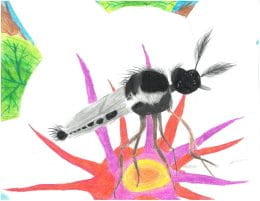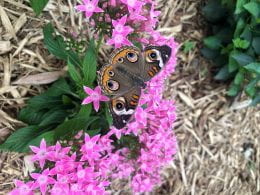By Frannie Miller, Pesticide Safety and IPM Coordinator
All around us, insect superheroes are industriously keeping us fed and our world moving forward whether we take time to notice them or not. Did you realize that pollinators like bees, wasps, butterflies, and bats are responsible for pollinating one out of every three bites of food we eat? The stability of our food supply relies on more than 200,000 species of pollinators. As we celebrate National Pollinator week (June 19-25, 2023), it is a good time to focus on insects which may not get as much glory for providing pollination as those we commonly hear about, like honeybees.
For example, tiny insects called thrips (order Thysanoptera) can play a big role in eating and spreading pollen. Thrips feed on pollen and are quite messy. It is estimated a single thrip can get up to 10 to 50 pollen grains on his body, which does not seem like much, but since they are often present in large numbers that can equate to a lot of pollen movement. These insects fly from plant to plant using the stigma as a landing and take-off point. The pollen is easily transferred from the insect to the stigmas during this process. Thrips are important to the pollination of sugarcane and the mahogany tree, but it is important to point out too many thrips can also cause plant damage and transmit diseases, so their presence is not always wanted.
Hoverflies (order Diptera) also known as flower flies are “incidental” yet prolific pollinators. The adult flies hover over flowers to drink the nectar. Pollen is transferred between the fly and the flower when their hairy bodies brush up against the stigma of the flower. Hoverflies may not carry as much pollen as bees, but they visit the flowers more frequently. These insects prefer small, flat flowers which allow easy access to the nectar, but they do visit a wide variety of our global food crops and flowers.

For those of us who like eating chocolate, then the chocolate midge (order Diptera) is of extreme importance. These midges seem to be the only creatures which can find their way into the long, twisty, intricate flowers of the Cacao tree to provide pollination. Their pollination duties are most active at dawn and dusk to be in sync with when the flowers are fully open. This pollination allows the prized seed pods to form, which are needed to produce chocolate. Interestingly enough these insects are threatened by clearing cutting of the rain forest as they need the damp rotting leaf litter on the forest floor to thrive.

These are just a few examples of the limited knowledge of the true depth of pollinators. In the state of Kansas, it is estimated that there are over 400 different native bee species.
We can help pollinators by growing a diversity of pollinator-friendly plants to help increase the availability of food sources. Check out the publication “Pollinators and Beneficial Insects”(https://bookstore.ksre.ksu.edu/pubs/MF3588.pdf) for a list of possible plants. In celebration of National Pollinator week, consider purchasing one new food or nectar plant to plant in your landscape or doing your own research to identify one lessor known pollinator. You can also place a shallow dish of water on the ground to provide water for pollinators. Help to inform others about the importance of pollinators and inspire them to make a difference!

